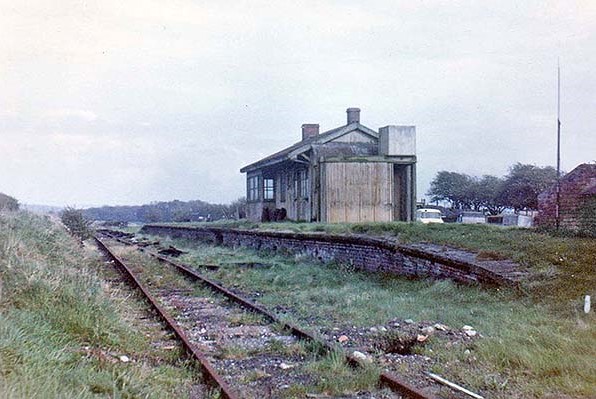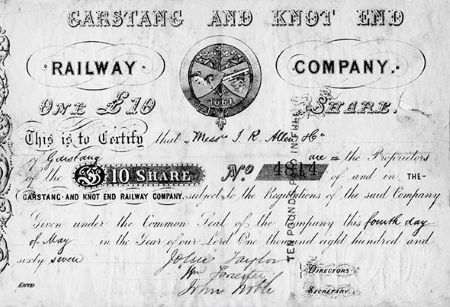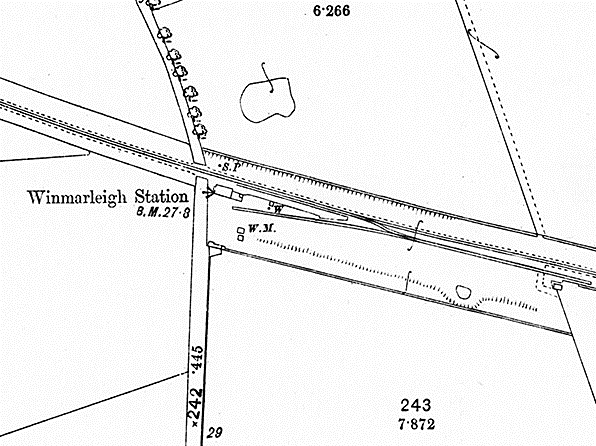 Nateby station looking east in 1965 shortly before the track was lifted.
Nateby station looking east in 1965 shortly before the track was lifted.
Photo by Roy Scott from Ian 1B’ Flickr photostream
In the early years of the nineteenth century the area around the village of Nateby was an unworked expanse of moss. In December 1863 the Garstang& Knot (sic) End Railway (G&KER) company was formed to create an 11½ mile line that would unlock the potential of the land in the area. In their early publications grand ideas were put forward that included their line becoming part of an alternative route to the north-east of England. The idea that Knott End might be developed as a major port to rival nearby Fleetwood was also discussed. These statements alarmed the bigger railway companies who objected to the proposals, which incurred a great deal of cost for the G&KER. In the end they had to modify their aspirations and submit their bill as very much a local railway that would serve only the local area. The railway was authorised on 30 June 1864.
From the start there were financial difficulties. The Parliamentary Act had authorised £60,000 in share capital, but the G&KER was unable to raise the subscriptions required. By December 1867 only half a mile of line had been created and it became clear that creating the route to Knott End was not going to be possible so the plans for the route west of Pilling were abandoned.
The single track line, of only 7 miles between the LNWR Garstang station (which started to be referred to as the ‘Junction’ station) and Pilling, opened on 5 December 1870. There were intermediate stations at Garstang (the town) and Nateby (then called Winmarleigh). The line had cost £106,715.
 Winmarleigh station was 4 miles from Garstang (Junction) and it was located to the north of Nateby. The original intention had been to locate the station further to the west at Cogie Hill but representations were made to the G&KER by two local landowners and their tenant farmers who wanted the station at the site on which it was actually built. The name Winmarleigh was chosen in deference to Lord Winmarleigh of Winmarleigh Hall. The course of the line at Nateby passed over Lord Winmarleigh’s land and being short of funds the G&KER had obtained the land for the railway through a leasehold agreement. Winmarleigh station was 4 miles from Garstang (Junction) and it was located to the north of Nateby. The original intention had been to locate the station further to the west at Cogie Hill but representations were made to the G&KER by two local landowners and their tenant farmers who wanted the station at the site on which it was actually built. The name Winmarleigh was chosen in deference to Lord Winmarleigh of Winmarleigh Hall. The course of the line at Nateby passed over Lord Winmarleigh’s land and being short of funds the G&KER had obtained the land for the railway through a leasehold agreement.
The location that had been requested by the landowners and farmers did not have a made up road but contractors’ drawings showed that there was a farm track there. A roadway had to be constructed which became Station Road. The railway crossed Station Road by means of a level crossing and a two storey crossing keeper’s cottage, one of six built in the same style, was provided on the east side of the road on the south side of the line.
The station was also to the east of Station Road. The passenger facilities consisted of a single platform that was located to the east of the cottage and was also on the south side of the line. A simple timber hut served as a booking office and waiting room. There was no passing loop at the station.
Goods facilities consisted of a yard and a siding located to the rear of the passenger platform. The siding had a loading ramp and it was connected to the main line at the eastern end of the station via a headshunt. The station was important to the Winmarleigh Estate and its tenant farmers and they wanted a weighbridge to be located there. The G&KER could not afford the weighbridge so in 1870 permission had been given to local farmers, headed by Mr Thornton, to install one at their expense. It appears that the weighbridge was not installed at that time as a company minute from 22 January 1876 records permission being given once again to Mr Thornton for the weighbridge. It is shown on the 25-inch scale map of 1892 (see below) so it is likely that it was installed on the second occasion.

At the time of opening there were two arrivals and two departures which ran as mixed passenger and goods. To operate the train services the G&KER had acquired an 0-4-2 saddle tank named ‘Hebe’ through a hire purchase arrangement. On 12 October 1870 a group of debenture holders had formed the Garstang Rolling Stock Company (GRSC) and they purchased four passenger coaches.
Having only one locomotive caused problems and when ‘Hebe’ needed major repairs in March 1872 the line had to close for two days. On 11 March 1872 the passenger service had to be suspended and although it restarted for a period further problems brought an end to locomotive haulage on 29 March 1872. Occasional goods services were operated after this date using horses for traction.
This dire state of affairs was resolved in the early months of 1875 when the debenture holders purchased an 0-4-0T locomotive named ‘Union’. On 23 February 1875 goods services resumed followed by passenger services on 17 May 1875. There was a basic passenger service of five trains in each direction with variations on Thursdays and Saturdays to accommodate those wishing to travel to and from the market at Garstang.
In December 1875 a further engine was purchased. It was an 0-6-0ST named ‘Farmers Friend’ and it went into service in 1876. It had a distinct high pitched whistle and locals began to call it the ‘Pilling Pig’. That name stuck and began to be applied (unofficially) to subsequent engines that operated on the line.
In 1878 the railway was placed in the hands of a receiver as it was unable to meet its financial obligations.
In 1881 the LNWR had renamed their Garstang station as Garstang & Catterall.
The G&KER had not been able to make the required payments to the Winmarleigh Estate for the ground rent relating to leasehold agreement that had been reached when the line was built. This had caused problems for years but in 1893 a financial settlement was reached, although the opportunity had been taken to impose certain conditions on the railway for the benefit of the tenants. One of these related to the provision of siding accommodation at the station on the north side of the line, specifically for the use of the farmers. It does appear that there was in fact a siding here by 1909, which crossed the road outside the level crossing gates and ended at the station platform. It was fairly short lived as it does not appear on any of the Ordnance Survey maps.
The December 1895 timetable showed Winmarleigh as having four arrivals and four departures Monday-to-Saturday. The first train arrived at the station at 7.10am and the first departure left at 7.50am.
In 1894 consideration was given to continuing the line to Knott End. As the G&KER could not raise the capital required, on 12 August 1898, Parliamentary authority was obtained for the Knott End Railway (KER) to extend the line from Pilling to Knott End.
In 1902 the station was renamed as Nateby (Lord Winmarleigh had died by that time).
The 1904 Handbook of Stations showed Nateby was capable of handling general goods, parcels, livestock and horses. There was no lifting crane at the station.
As things turned out the KER had just as much difficulty in raising capital as the G&KER. They also ended up in a legal dispute with their contractor and in the end it took them ten years to build a 4½ mile length of railway. Having two companies for an 11½ mile railway was not practical so on 1 July 1908 the KER bought the G&KER for £44,690. Passenger services began to serve Knott End on 30 July 1908. There was one intermediate station on the new section of line.
After the opening of the extension modernization works were carried out along the length of the former G&KER line. Nateby station was improved during the first half of1909. A passing loop was put in, so as to provide additional capacity when handling the increased summer passenger traffic that the extension to Knott End brought to the railway. This extended over the level crossing. The existing platform, which became the down (westbound) direction, was lengthened and brought up to modern standards and a second, up (eastbound direction) platform, was put in to serve the north side of the loop. Both platforms were 250 feet long and 12 feet wide. On the existing platform the wooden hut, probably the one dating from the 1870s, was replaced by a new station building constructed of timber and corrugated iron, incorporating a booking office, waiting rooms and toilets for both sexes. Signaling was installed at Nateby by the Railway Signaling Company. A lever frame controlling the points and signals was situated in a separate room on the end of the building, which was wider at this point than the rest of the structure. Windows were provided on two sides together with a west facing half bay window on the platform so that the signalman had a clear view of the level crossing.
The 1910 revision of the 25 Inch Ordnance Survey shows that by this time an additional siding had been laid in the yard and the head shunt had been extended. The new siding served a loading mound and a cattle dock. It is likely that most of this work was carried out in 1909 along with the upgrading of the passenger facilities.
Nateby station was unique on the line in that it never had a crane in the yard, perhaps because the traffic here was almost exclusively agricultural produce. Although situated away from any significant settlement, the station appears to have seen regular goods traffic especially during the potato harvest.
From 1911 a new branch line, which had been built from a point near Knott End to the Preesall salt works, started to be used and large tonnages of rock salt (outbound) and coal (inbound) was handled by the KER.
By 1920 bus services had become established in the area. The number of passengers carried on the line slumped from 112,000 in 1920 to 77,579 in 1922. As a means of countering this competition in the summer of 1920 the KER line hired a steam railmotor from the LNWR. The railmotor enabled the KER to cut expenditure and to provide a more flexible passenger service. At first the railmotor was used in addition to the locomotive hauled service during the summer season and for all passenger services in the winter period. However the passenger traffic at Nateby remained light and by 1921 it had become a request only stop, but it was still served by all trains.
The July 1922 timetable showed seven up and eight down services as shown in the timetable below.

On 1 July 1923 the KER was absorbed into the London Midland & Scottish Railway (LMS). It was the smallest of the companies that was grouped into that organisation.
Under the LMS most of the passenger services continued to be operated by the railmotor.
On 31 March 1930 the LMS withdrew the passenger service from the line. The last LMS working timetable that showed a passenger service, which came into effect from 23 September 1929, showed six up and five down passenger services. All bar the first down service which departed from Garstang Town for Knott End at 7.15 were worked by the railmotor.
After the withdrawal of the passenger service Nateby became a goods only station.
On 1 January 1948 the line became part of British Railways London Midland Region (BR[LMR]). On 13 November 1950 BR[LMR] closed Nateby completely. The line between Pilling and Knott End was also closed at the same time. Goods facilities remained available at Pilling and at Garstang Town.
After complete closure of the station the down line of the passing loop and the goods sidings were removed. This had certainly been done by 1956 when the individual line sections for train staff working had been abolished and replaced by one staff covering the remaining line between Garstang & Catterall and Pilling.
On 1 August 1963 goods services ceased running between Garstang Town and Pilling. The track was lifted sometime after 1965 and Nateby station and the crossing keeper’s cottage had been demolished by 1975.
With special thanks to Dave Richardson author of The Pilling Pig - A History of the Garstang & Knott End Railway |

 Home
Page
Home
Page

 Home
Page
Home
Page